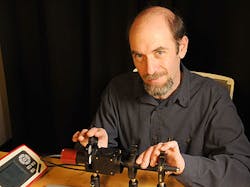NIST tests green laser pointers, finds many don't meet federal safety regulations
Boulder, CO--Using a low-cost apparatus designed to quickly and accurately measure the properties of handheld laser devices, National Institute of Standards and Technology (NIST) researchers tested 122 laser pointers and found that nearly 90% of green pointers and about 44% of red pointers tested were out of compliance with federal safety regulations. The NIST test apparatus was designed so that it can be replicated easily by other institutions.
Related: Beware the dim green laser pointer, says NIST
A NIST researchers reported at a conference on March 20, 2013, both red and green laser pointers often emitted more visible power than allowed under the Code of Federal Regulations (CFR), and green pointers often emitted unacceptable levels of infrared (IR) light as well.1
Anecdotal reports of green laser hazards have previously appeared in scientific journals and the media, but the new NIST tests are the first reported precision measurements of a large number of handheld laser devices. The NIST tests point out that many red laser pointers are also—unexpectedly—out of compliance with federal regulations. "Our results raise numerous safety questions regarding laser pointers and their use," the new paper states.
Worst: more than 10 times the legal limit
The NIST tests were conducted on randomly selected commercial laser devices labeled as Class IIIa or 3R and sold as suitable for demonstration use in classrooms and other public spaces. Such lasers are limited under the CFR to 5 mW maximum emission in the visible portion of the spectrum and less than 2 mW in the IR. About half the devices tested emitted power levels at least twice the CFR limit at one or more wavelengths. The highest measured power output was 66.5 mW, more than 10 times the legal limit. The power measurements were accurate to within 5%.
According to the American National Standards Institute (ANSI), laser devices that exceed 3R limits may be hazardous and should be subject to more rigorous controls such as training, to prevent injury.2
Technical staff from NIST's Laser Radiometry Project built the laser pointer test bed and collaborated with the NIST Office of Safety, Health and Environment on the tests. NIST has provided its data on laser-pointer power measurements to the Food and Drug Administration, which regulates laser product safety.
Green lasers generate green light by upconverting IR to green. Ideally, the device should be designed and manufactured to confine the IR light within the laser housing. However, according to the new NIST results, more than 75% of the devices tested emitted IR light in excess of the CFR limit.
NIST laser safety officer Joshua Hadler designed the measurement test bed.3 The system consists of a laser power meter and two optical filters to quantify the emissions of different wavelengths of visible and IR light. The power meter and filters were calibrated at NIST. Lens holders ensure repeatable laser alignment, and an adjustable aperture contains the laser light around the output end of the laser.
"The measurement system is designed so that anyone can build it using off-the-shelf parts for about $2,000," Hadler says. "By relying on manufacturers' traceability to a national measurement institute such as NIST, someone could use this design to accurately measure power from a laser pointer."
REFERENCES
1, J. Hadler. Random testing reveals excessive power in commercial laser pointers. Presentation at the International Laser Safety Conference, Orlando, Fla., March 20, 2013; J. Hadler, E.L. Tobares and M. Dowell. Random testing reveals excessive power in commercial laser pointers. Journal of Laser Applications. (Forthcoming.)
2. American National Standard for the Safe Use of Lasers (ANSI Z136-2007) Section 1.2 and Table 1. Lasers that exceed 3R emissions limits are classified as 3B or 4.
3. J. Hadler and M. Dowell. Accurate, inexpensive testing of laser pointer power for safe operation. Measurement Science and Technology. Published online March 7, 2013.

John Wallace | Senior Technical Editor (1998-2022)
John Wallace was with Laser Focus World for nearly 25 years, retiring in late June 2022. He obtained a bachelor's degree in mechanical engineering and physics at Rutgers University and a master's in optical engineering at the University of Rochester. Before becoming an editor, John worked as an engineer at RCA, Exxon, Eastman Kodak, and GCA Corporation.
